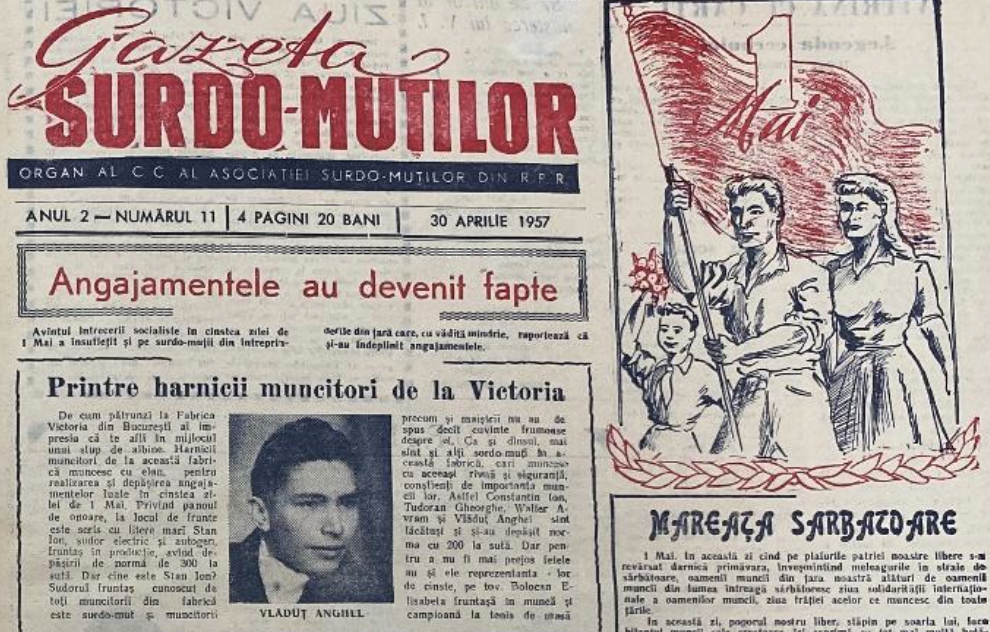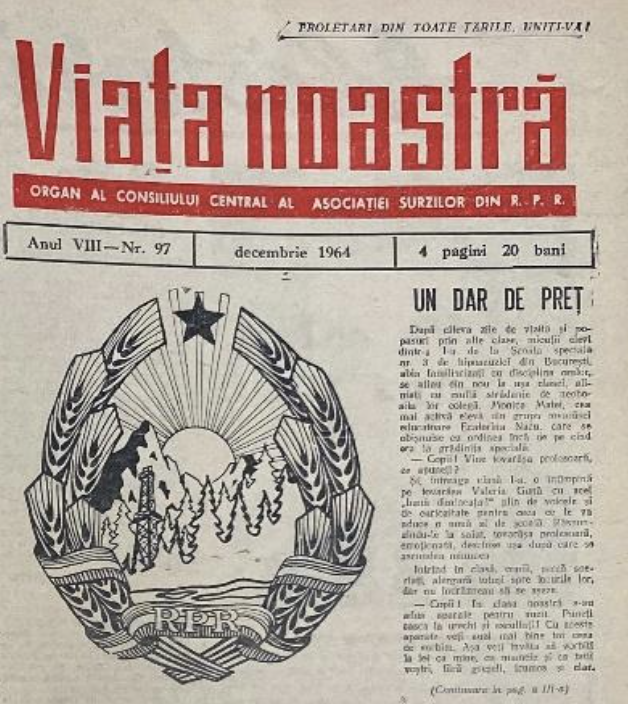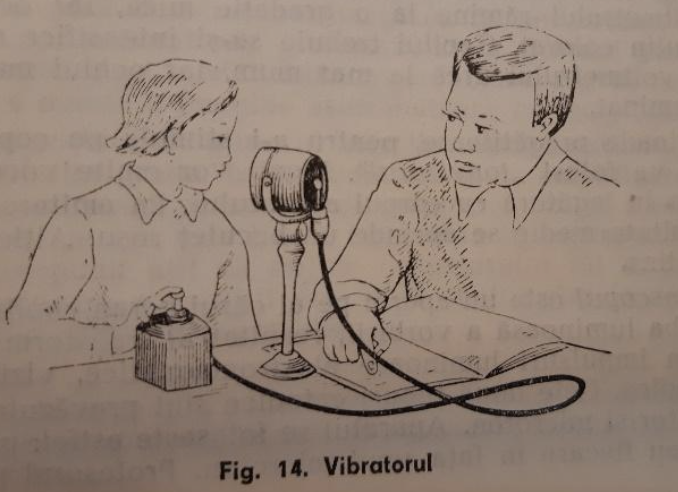In recent years, there has been a steady increase in historical research on disability in Eastern Europe. A significant development has taken place with the creation of a working group, which is led by Maria Bucur and Maria Galmarini and hosted by the Association for Slavic, East European, and Eurasian Studies (ASEEES 2023). Another noteworthy initiative is the “Disability Studies in Eastern Europe – Reconfigurations” research platform, initiated by Magdalena Zdrodowska at Jagiellonian University in Kraków (Jagiellonian University 2023). These endeavors, and a host of historical studies that have been published during the past decade, have enhanced our comprehension of disability in Eastern Europe and have played an important role in de-centering disability history. Still, a majority of these works revolve around Soviet and Central European case studies, leaving the exploration of disability in other countries, such as Romania, at a relatively early stage (Dinu 2022a).
Within the confines of this text, I will explore the history of the deaf community in Romania during state socialism (1947-1989). The primary reason for focusing on Romania is the scarcity of historical research that delves into the experiences of non-Western deaf communities and the prevalent perceptions of deaf people among the hearing majority in Eastern Europe. The objective of this blog post is thus to discuss previously unexplored sources that provide insights into an understudied minority group. Still, one might ask why a case study on yet another Eastern European country is necessary? An incorporation of lesser-studied cases such as Romania has the potential to challenge the longstanding Cold War narrative of Eastern Europe as a monolithic block and underscores the need for differentiated perspectives. Certainly, in the post-war era, several domains, including disability research, special education, or the state-controlled associations of the deaf and the blind in socialist countries, were initially shaped by Soviet blueprints, fostering commonalities across the socialist world. However, upon closer examination, distinctions emerge that were influenced by local traditions. Romanian psychologists and special educators acknowledged their indebtedness to domestic traditions from the interwar era and combined them with Soviet models (Dinu 2022b). In other socialist countries, such as Czechoslovakia, approaches to disability also merged autochthonous traditions with Soviet influences (Henschel and Shmidt 2019).
Compared to other European countries, the first association of the deaf was established relatively late in Romania, in 1919, under the auspices of Marie, the last Queen of Romania. After the communist takeover in 1947, philanthropic and other non-governmental organizations were banned. It was not until 1953 that a new national association of the deaf was re-established by the communist authorities, with its operations being rigorously controlled by the Ministry of Labor.
The postwar era presents a challenge to historians due to the lack of archival material at the association of the deaf, as well as the inaccessibility of a substantial volume of archival materials from the Ministries of Labor and Social Welfare – two governmental bodies that held responsibility for the well-being of deaf and disabled individuals during that time. Despite these hurdles, there are means to study the history of the deaf in Romania. One avenue that I have begun to explore involves studying the official journal circulated by the association of the deaf: The Deaf-Mutes’ Journal (Gazeta Surdo-Muților) published from 1956 to 1960, which was renamed into Our Life (Viața Noastră) in 1963 (hereafter referred to as the Journal).


Title pages of the “Deaf-Mutes’ Journal” (Gazeta Surdo-Muților) and “Our Life” (Viața Noastră).
As I delved into the contents of the Journal, my attention quickly gravitated towards the role of sign language and the prevalence of oralism and audism. This dimension holds considerable importance, as the standing of sign language offers valuable insights into the misrecognition of deaf people within hearing societies. Furthermore, concerning the issue of sign language, the post-war socialist world was far from homogenous. Unlike in the Soviet Union, where sign language found public usage and access to interpreters was feasible (Shaw 2017), the utilization of sign language in public spaces was notably limited in Romania.
The widespread practice of oralism can be attributed in part to the adoption of central and western European educational models since the 19th century (Baican and Ionescu 1884). Throughout the inter-war period, oralism continued to gain ground, propagated by educators such as Ion Ciorănescu and Dimitrie Rusticeanu (a.k.a. Rusceac), who drew strong inspiration from German models in deaf education (Ciorănescu 1934; Rusceac 1933). As in many other countries, “pure oralism” was at its peak during these years and the predominant approach was to teach deaf people to speak, or, as Romanian educators put it, to “unmute” (demutiza) the deaf. For instance, in the context of articulation training, educators employed devices such as vibrotactile aids or tools crafted from nickel-plated wire that served the purpose of guiding the tongue into precise positions necessary for “correctly” articulating various vowels and consonants (Măescu-Caraman and Caraman 1983). To be sure, this method, ethically objectionable from our perspective due to its infringement upon students’ bodily autonomy, was not new. It had already been employed during the 18th century, as seen in the case of Thomas Braidwood in Scotland, for instance.


Images from a textbook for educators of deaf students (see footnote 8).
Another trend that emerged during the post-war years and additionally perpetuated prewar oralist traditions was defectology, an interdisciplinary field of disability research that drew on Soviet blueprints and merged them with autochthonous traditions (Dinu 2022b). The pages of the deaf Journal contain illustrative examples that illuminate the widespread practice of oralism and the associated stigmatization of sign language. In the inaugural edition of the Journal, which dates back to 1956, an article elaborated on the foundational principles of defectological research during that era in order to convey them to the deaf community:
“Following the example of the highest of all sciences – the Soviet science – the deaf-mute problem has found its solution. In vocational schools we aim to teach deaf-mute students spoken language by unmuting them, thus enabling them to qualify for a profession, which is demanded for the construction of socialism. By reaching these goals, we successfully integrate the deaf-mutes into society […] We know from Stalinist teachings that thinking is not detached from [spoken] language and that ‘language is the immediate reality of thought’. Consequently, if the deaf-mute does not speak, this means that he does not think either” (Gazeta Surdo-Muților 1956, 1).
Moreover, the author referred to Ivan Pavlov’s classical theory of conditioned reflexes, which was the dominant paradigm in both medical science and defectology during that time. The central idea behind this theory was that spoken language was crucial to develop what Pavlov referred to as the “second-signal system,” which distinguishes language acquisition in humans from first-signal conditioning in animals. Exerting a considerable influence within expert circles, the medical gaze wielded a lasting impact on the deaf community and solidified audism within the hearing society.
Another example of this outlook can be found in a 1958 article on the living conditions of the deaf in the USSR. While the author acknowledged that deaf workers in the USSR had access to sign language interpreters (a benefit that was not available to deaf people in Romania), the article also emphasized that deafness was on the verge of being eradicated:
“In the Soviet Union, efforts are being made to combat deaf-muteness through medical means with the assistance of [state authorities]. As Soviet authorities have devoted considerable attention to social work, this endeavour has resulted in a steady decrease in the number of individuals suffering from deaf-muteness in the country” (Gazeta Surdo-Muților 1958, 2).
A further dimension showcasing negative attitudes towards sign language relates to pantomime performances, which held significance in the cultural life of deaf clubs, providing the deaf community with channels for visual expression and valuable socializing opportunities. Nevertheless, despite their popularity, the debate over the use of sign language remained controversial and resembled conflicts in other countries in the middle of the 20th century. In 1966, the artistic instructor from the Cluj branch of the deaf association criticized the use of sign language during pantomime performances and urged the deaf community “to understand, that signing is not a component of pantomimic expression and has nothing in common with this art form.” (Viața Noastră 1966, 9).
These interventions highlight the Journal’s intended role: disciplining the deaf community and enforcing normalcy by imposing oral communication. In addition, these instances shed light on how state authorities and experts viewed it as their duty to “civilize” the deaf through suppressing sign language, an effort that was closely connected to the expectation that deaf people would eventually assimilate completely into the mainstream socialist society.
These preliminary findings not only underscore the unique aspects of the Romanian experience of deafness but also emphasize the imperative for further research. Claire Shaw’s study on deafness and socialist internationalism in the post-war era also underscored this facet: Despite Soviet representatives’ aim to cultivate a “pan-socialist deaf identity,” the diverse approaches to deafness within the socialist world frequently posed challenges to this aspiration (Shaw 2021, 55).
There is still much uncharted territory when it comes to deafness and disability in Eastern Europe, a notion particularly evident when examining the Romanian case. However, in spotlighting the experiences of the deaf community here, the objective was not solely to introduce another case study or bring yet another minority group’s history to the forefront. Instead, by illuminating the intricacies of deafness during the state-socialism era, we have the potential to gain broader insights into notions of normality within the post-war socialist world.
—
Bibliography
ASEEES – Association for Slavic, East European, and Eurasian Studies. 2023. “Working Group on Disability Studies.” Accessed November 2, 2023. https://www.aseees.org/about/affiliate/interest-groups.
Baican, Eugen, and Nicolae Ionescu, Noţiuni de articulaţie sau instrucţiuni pentru a face să vorbească surdo-muţii. Bucharest: Unknown.
Ciorănescu, Ion. 1934. Eu învăţ să vorbesc : carte pentru elevii clasei a II-a şi a III-a a şcoalelor de surdo-muţi : cu 172 clişee. Cernăuţi: Regina Maria.
Dinu, Radu Harald. 2022a. “Recent Historiographical Trends in Scholarship on Disability and Socialism in Eastern Europe.” Scandinavian Journal of Disability Research 24, no. 1 (February): 42–53. https://doi.org/10.16993/sjdr.829.
Dinu, Radu Harald. 2022b. “Medical discourses on dis/ability in state socialist Romania: A critical genealogy.” In Dis/ability in media, law and history: Intersectional, embodied and socially constructed?, edited by Micky Lee, Frank Rudy Cooper, and Pat Reeve, 76–89. London: Routledge. https://doi.org/10.4324/9781003257196-7.
Gazeta Surdo-Muților.
Henschel, Frank, and Victoria Shmidt. 2019. “Special Education in Czechoslovakia between 1939 and 1989.” In The Politics of Disability in Interwar and Socialist Czechoslovakia, edited by Victoria Shmidt, 109–144. Amsterdam: Amsterdam University Press. DOI: https://doi.org/10.2307/j.ctvdmx10t.11.
Jagiellonian University. 2023. “Disability Studies in East Europe – Reconfigurations.” Accessed November 2, 2023. https://disability-in-easteurope.project.uj.edu.pl/en_GB.
Măescu-Caraman, Lucia, and Alexandru Caraman. 1983. Metodologia Procesului Demutizării. Bucureşti: Editura Didactică şi Pedagogică.
Rusceac, Dimitrie. 1933. Iniţierea surdo-muţilor în limbajul auditiv Cernăuţi: Regina Maria.
Shaw, Claire. 2017. Deaf in the USSR: marginality, community, and Soviet identity, 1917-1991. Ithaca: Cornell University Press
Shaw, Claire, Deaf in the USSR: marginality, community, and Soviet identity, 1917-1991, 27-62. Ithaca: Cornell University Press.
Viața Noastră.
—
Radu Harald Dinu is an Assistant Professor of history at Jönköping University, Sweden. His research focuses on disability history and the modern and contemporary history of Eastern Europe. Dinu is also coordinating the Swedish Network For Critical Disability Studies (KritFunk).